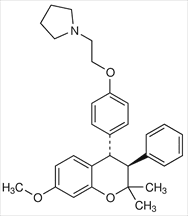Routes ofadministration Oral Biological half-life 7 days CAS Number 78994-24-8 | ATC code G03XC04 (WHO) Synonyms Centchroman Molar mass 457.604 g/mol | |
 | ||
Trade names Centron, Novex-DS, Saheli, Sevista | ||
Ormeloxifene (also known as centchroman) is one of the selective estrogen receptor modulators, or SERMs, a class of medication which acts on the estrogen receptor. It is best known as a non-hormonal, non-steroidal oral contraceptive which is taken once per week. In India, ormeloxifene has been available as birth control since the early 1990s, and it is currently marketed there under the trade name Saheli. Ormeloxifene has also been licensed under the trade names Novex-DS, Centron, and Sevista.
Contents
Medical uses
Ormeloxifene is primarily used as a contraceptive but may also be effective for dysfunctional uterine bleeding and advanced breast cancer.
Birth control
Ormeloxifene may be used as a weekly oral contraceptive. The weekly schedule is an advantage for women who prefer an oral contraceptive, but find it difficult or impractical to adhere to a daily schedule required by other oral contraceptives.
For the first twelve weeks of use, it is advised to take the ormeloxifene pill twice per week. From the thirteenth week on, it is taken once per week. The consensus is that backup protection in the first month is a cautious but sensible choice. A standard dose is 30 mg weekly, but 60 mg loading doses can reduce pregnancy rates by 38%.
It has a failure rate of about 1-2% with ideal use which is slightly less effective than found for combined oral contraceptive pills.
Other indications
Adverse effects
There are concerns that ormeloxifene may cause delayed menstruation.
Method of action
Ormeloxifene is a selective estrogen receptor modulator (SERM). In some parts of the body, its action is estrogenic (e.g., bones), in other parts of the body, its action is anti-estrogenic (e.g., uterus, breasts.) It causes an asynchrony in the menstrual cycle between ovulation and the development of the uterine lining, although its exact mode of action is not well defined. In clinical trials, it caused ovulation to occur later than it normally would in some women, but did not affect ovulation in the majority of women, while causing the lining of the uterus to build more slowly. It speeds the transport of any fertilized egg through the fallopian tubes more quickly than is normal. Presumably, this combination of effects creates an environment such that if fertilization occurs, implantation will not be possible.
Marketing
As of 2009, ormeloxifene was legally available only in India.
Ormeloxifene has been tested and licensed as a form of birth control, as well as a treatment for dysfunctional uterine bleeding.
